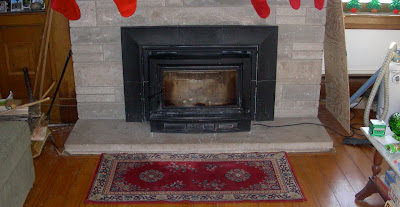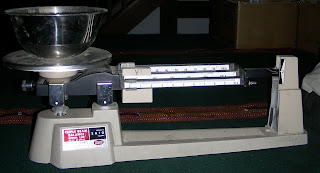 Winter often brings with it a desire to be somewhere warm, dry, and cozy. We live in a farm house that was built sometime in the second half of the 1800's and, though its 18" thick brick walls make it far from drafty, one needs a good way to heat it.
Winter often brings with it a desire to be somewhere warm, dry, and cozy. We live in a farm house that was built sometime in the second half of the 1800's and, though its 18" thick brick walls make it far from drafty, one needs a good way to heat it.The house was built with one big chimney through which passed the exhaust from three fireplaces, one in the basement, one on the first floor, and one on the second floor - all directly in line vertically. When Mom bought the house the second floor fireplace had been removed, leaving the lower two. And we were soon surprised by the reality that when we lit a fire in the living room the basement would get smoky. Upon professional inspection it was found that the flues had been designed to join into each other. The chimney sweep had never seen anything like it before, and subsequent professionals we've had out think we're pulling their legs when we tell them about it.
But that problem has long since been fixed, and a few years back we had a liner put up the chimney and a fireplace insert installed in the living room fireplace, which is the one that gets regular use. Those familiar with wood heat, thermodynamics, and/or general trivia know that fireplaces are pretty, but absolutely impossible to heat a house with. Almost all of the heat generated goes straight up and out the chimney via hot air, creating low pressure in the house, which in turn pulls air (that would be cold air) from the outdoors through any crack available. The result is a beautiful visual feature warming those directly beside it, paired with a constant draft in other parts of the house
A fireplace insert is a like a woodstove that only has a nice-looking front, since the rest is nestled into the fireplace cavity. The advantage over a free-standing woodstove is that it takes up less space. Both are designed as chambers that burn wood more efficiently (and distribute heat much more efficiently) than a fireplace. We got one called the Clydesdale, made by Hearthstone.
In terms of wood-burning efficiency it worked fine, but in the heating department it came up way short. Inserts depend on a fan (see the electric cord off to the right of the stove) which blows air through channels that go behind, around, and back out the front of the exterior of the stove - that's how the heat radiated by the insert gets moved from the fireplace cavity to the room you're trying to heat. The problem with the Clydesdale was that the fan didn't work very well, and was very noisy. Then the thermostat element in it broke, then the function that lets you moderate the fan's speed broke.
This year we decided that the insert just wasn't doing it for us. For all the heat it produced it could not heat the house, and for it to even work as well as possible it needed this fan on that often made listening to conversation or music difficult. We wanted something that could radiate its heat without use of any fan, and that meant a free-standing wood stove. An added bonus was a surface we could conceivably cook on, heat water on, warm socks on, etc.
something that could radiate its heat without use of any fan, and that meant a free-standing wood stove. An added bonus was a surface we could conceivably cook on, heat water on, warm socks on, etc.
 something that could radiate its heat without use of any fan, and that meant a free-standing wood stove. An added bonus was a surface we could conceivably cook on, heat water on, warm socks on, etc.
something that could radiate its heat without use of any fan, and that meant a free-standing wood stove. An added bonus was a surface we could conceivably cook on, heat water on, warm socks on, etc.We consulted a great fireplace shop in the Richmond area, actually The Fireplace Shop, and settled on a soapstone stove (for soapstone's many wonderful characteristics). While waiting for delivery, we thought maybe we'd prepare the way by getting the Clydesdale ready to depart. Inserts, it turns out, are stuck in the cavity and surrounded by insulation, then a collar is put over what remains of the gap between the fireplace front and the insert. That's so you can't see the ugly back. Once we took the collar off and the insulation out, we found that the heat truly poured forth. It was pretty amazing. To make the thing really effective the fan still needed to be on, but even without it there was A LOT of heat. If we had only known that we might not have gotten a new stove, but since it was on its way already, and because of the new stove's attributes, we stayed the course.
 Because it sticks out further than the insert we needed more insulative material, so we got a piece of limestone (set on two pieces of Mycor) to match the existing hearth. So here is our beautiful new stove, the Hearthstone Heritage (my, aren't we refined?). It is a hit with the cat, the laundry, and the rest of us, and we all look forward to figuring out how to maximize its performance and charm.
Because it sticks out further than the insert we needed more insulative material, so we got a piece of limestone (set on two pieces of Mycor) to match the existing hearth. So here is our beautiful new stove, the Hearthstone Heritage (my, aren't we refined?). It is a hit with the cat, the laundry, and the rest of us, and we all look forward to figuring out how to maximize its performance and charm.
The Clydesdale will find a place in the workshop, and possibly eventually in another home. I have fantasies about using it in a cob-masonry stove kind of application in the future.
 Because it sticks out further than the insert we needed more insulative material, so we got a piece of limestone (set on two pieces of Mycor) to match the existing hearth. So here is our beautiful new stove, the Hearthstone Heritage (my, aren't we refined?). It is a hit with the cat, the laundry, and the rest of us, and we all look forward to figuring out how to maximize its performance and charm.
Because it sticks out further than the insert we needed more insulative material, so we got a piece of limestone (set on two pieces of Mycor) to match the existing hearth. So here is our beautiful new stove, the Hearthstone Heritage (my, aren't we refined?). It is a hit with the cat, the laundry, and the rest of us, and we all look forward to figuring out how to maximize its performance and charm.The Clydesdale will find a place in the workshop, and possibly eventually in another home. I have fantasies about using it in a cob-masonry stove kind of application in the future.
To the credit of Hearthstone, this was one of the earliest versions of the Clydesdale, one with a few design flaws. When we went in to look for a new stove the folks at the Fireplace Shop asked us what we had.
"What? You have a Clydesdale? Why would you want to replace that? Oh, it's the old one. Never mind."
"What? You have a Clydesdale? Why would you want to replace that? Oh, it's the old one. Never mind."
2387


